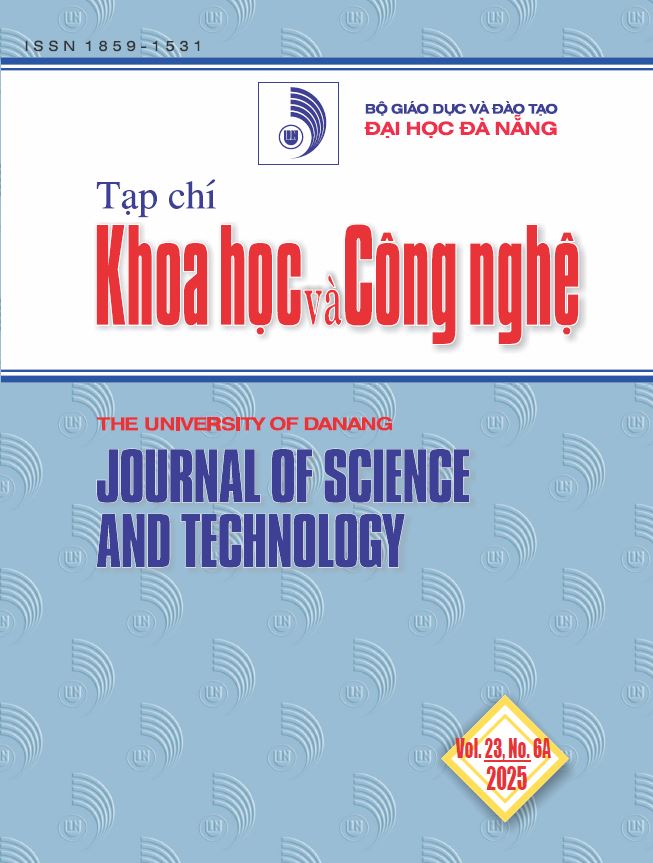Segregation-driven assembly of graphite fluoride using polymethyl methacrylate beads for enhanced thermal conductivity in flexible PDMS composites
 Tóm tắt: 169
Tóm tắt: 169
 |
|  PDF: 106
PDF: 106 
##plugins.themes.academic_pro.article.main##
Author
-
Mai Thi Kieu LienThe University of Danang - University of Science and Education, VietnamNguyen Thi My DucThe University of Danang - University of Science and Education, VietnamTran Thi HongThe University of Danang - University of Science and Education, VietnamTrinh Ngoc DatThe University of Danang - University of Science and Education, VietnamNguyen Thanh SonThe University of Danang - Advanced Institute of Science and Technology, VietnamNguyen Thanh HoiThe University of Danang - Center for Continuing Education, VietnamLe Hong NamThe University of Danang - University of Science and Technology, VietnamTran Thi Thu HienHung Vuong Secondary School, Phan Thiet, Binh Thuan, Vietnam
Từ khóa:
Tóm tắt
Flexible thermal interface materials are crucial for soft electronics, yet enhancing thermal conductivity without sacrificing mechanical compliance remains challenging. Herein, we present a facile approach to improve heat dissipation in Ecoflex elastomers by inducing graphite fluoride (GF) segregation using polymethyl methacrylate (PMMA) beads as spatial templates. Composites were fabricated with varying PMMA bead sizes (5–50 μm) and GF loadings (10–20 wt%) to optimize filler network morphology and thermomechanical properties. Scanning electron microscopy revealed that 25 μm beads effectively promoted GF segregation into continuous domains. As a result, thermal conductivity reached up to 9.23 W/mK at 20 wt% GF. Real-device testing with surface-mounted LEDs demonstrated superior heat dissipation, significantly reducing steady-state temperatures. This study highlights the effectiveness of bead-induced segregation in engineering soft, thermally conductive composites. The resulting materials offer a promising solution for wearable electronics, flexible displays, and soft robotics where mechanical flexibility and thermal performance must be simultaneously achieved.
Tài liệu tham khảo
-
[1] M. C. Vu et al., “Nacre-inspired nanocomposite papers of graphene fluoride integrated 3D aramid nanofibers towards heat-dissipating applications”, Chemical Engineering Journal, vol. 429, p. 132182, 2022.
[2] S. Li et al., “High thermal conductivity in cubic boron arsenide crystals”, Science (1979), vol. 361, no. 6402, pp. 579–581, 2018.
[3] J. Gu and K. Ruan, “Breaking Through Bottlenecks for Thermally Conductive Polymer Composites: A Perspective for Intrinsic Thermal Conductivity, Interfacial Thermal Resistance and Theoretics”, Nano-Micro Letters, vol. 13, no. 1, pp. 1–9, 2021.
[4] M. C. Vu, G. Park, Y. Bae, and S. Kim, “Enhanced Thermal Conductivity of Pressure Sensitive Adhesives Using Hybrid Fillers of SiC Microparticle and SiC Nanoparticle Grafted Graphene Oxide”, Polymer (Korea), vol. 40, no. 5, pp. 804–812, 2016.
[5] Y. H. Bae, M. J. Yu, M. C. Vu, W. K. Choi, and S. R. Kim, “Synergistic effects of segregated network by polymethylmethacrylate beads and sintering of copper nanoparticles on thermal and electrical properties of epoxy composites”, Compos. Sci. Technol., vol. 155, pp. 144–150, 2018.
[6] H. Chen et al., “Thermal conductivity of polymer-based composites: Fundamentals and applications”, Prog. Polym. Sci., pp. 1–45, 2015.
[7] N. Burger, A. Laachachi, M. Ferriol, M. Lutz, V. Toniazzo, and D. Ruch, “Review of thermal conductivity in composites: Mechanisms, parameters and theory”, Progress in Polymer Science, vol. 61, pp. 1–28, 2016.
[8] D. K. Nguyen et al., “Multilayered silver nanowires and graphene fluoride-based aramid nanofibers for excellent thermoconductive electromagnetic interference shielding materials with low-reflection”, Colloids Surf. A Physicochem. Eng. Asp., vol. 688, 2024.
[9] T. C. Nguyen, A. L. H. Pham, D. K. Nguyen, M. T. K. Lien, V. C. Nguyen, and M. C. Vu, “Ultrathin Aramid Nanofiber Composites with Alternating Multilayered Structure of Silver Nanowires and Boron Arsenide: Toward Superior Electrically Insulating Thermoconductive Electromagnetic Interference Shielding Materials”, ACS Appl. Electron. Mater., vol. 6, no. 5, pp. 3704–3716.
[10] V. Cuong Nguyen et al., “Layer-by-layer assembly of boron arsenide and copper nanoflake-based aramid nanofibers for thermoconductive electromagnetic interference shielding materials with superior mechanical flexibility and flame retardancy”, Journal of Industrial and Engineering Chemistry, vol. 138, pp. 492–501, 2024.
[11] D. K. Nguyen et al., “Ultratough and self-healable electromagnetic interference shielding materials with sandwiched silver nanowires in polyurethane composite films”, Polym. Compos., vol. 45, no. 16, pp. 14943–14952, 2024.
[12] D. K. Nguyen et al., “Thermoconductive Graphene Fluoride Cross-Linked Aramid Nanofiber Composite Films with Enhanced Mechanical Flexibility and Flammable Retardancy for Thermal Management in Wearable Electronics”, ACS Appl. Nano Mater., vol. 7, no. 3, pp. 2724–2734, 2024.
[13] V. C. Doan, M. C. Vu, N. A. T. Thieu, M. A. Islam, P. J. Park, and S. R. Kim, “Copper flake-coated cellulose scaffold to construct segregated network for enhancing thermal conductivity of epoxy composites”, Compos. B Eng., vol. 165, pp. 772–778, 2019.
[14] M. Shtein, R. Nadiv, M. Buzaglo, K. Kahil, and O. Regev, “Thermally conductive graphene-polymer composites: Size, percolation, and synergy effects”, Chemistry of Materials, vol. 27, no. 6, pp. 2100–2106, 2015.
[15] K. M. F. Shahil and A. A. Balandin, “Graphene-multilayer graphene nanocomposites as highly efficient thermal interface materials”, Nano Lett., vol. 12, no. 2, pp. 861–867, 2012.
[16] V. C. Doan, M. C. Vu, M. A. Islam, and S. R. Kim, “Poly(methyl methacrylate)-functionalized reduced graphene oxide-based core–shell structured beads for thermally conductive epoxy composites”, J. Appl. Polym. Sci., vol. 136, no. 9, p. 47377, 2019.
[17] M. C. Vu, Q. V. Bach, D. D. Nguyen, T. S. Tran, and M. Goodarzi, “3D interconnected structure of poly(methyl methacrylate) microbeads coated with copper nanoparticles for highly thermal conductive epoxy composites”, Compos. B Eng., vol. 175, pp. 107105–107113, 2019.
[18] M. D. Bartlett et al., “High thermal conductivity in soft elastomers with elongated liquid metal inclusions”, Proc. Natl. Acad. Sci. USA, vol. 114, no. 9, pp. 2143–2148, 2017.
[19] D. Mani et al., “3D structured graphene fluoride-based epoxy composites with high thermal conductivity and electrical insulation”, Compos. Part A Appl. Sci. Manuf., vol. 149, p. 106585, 2021.
[20] X. Wang and P. Wu, “Fluorinated Carbon Nanotube/Nanofibrillated Cellulose Composite Film with Enhanced Toughness, Superior Thermal Conductivity, and Electrical Insulation”, ACS Appl. Mater. Interfaces, vol. 10, no. 40, pp. 34311–34321, 2018.



